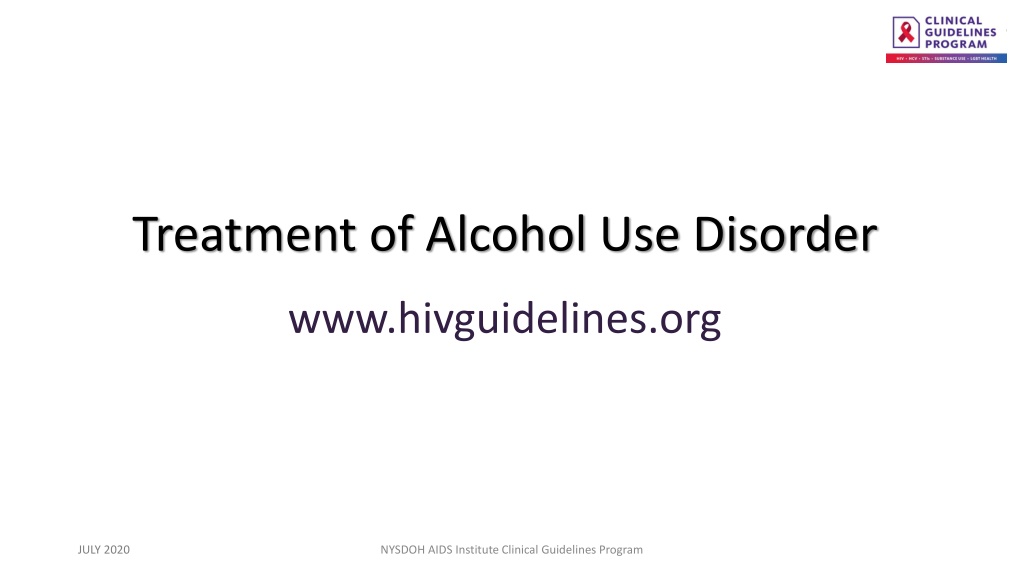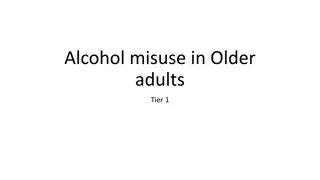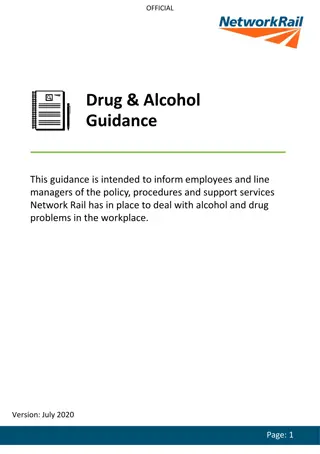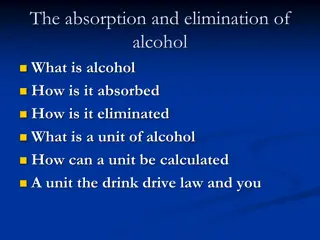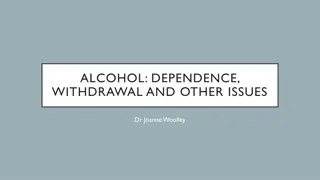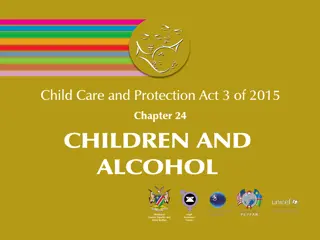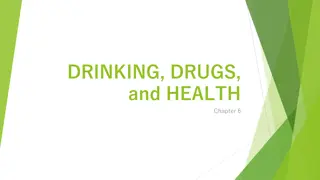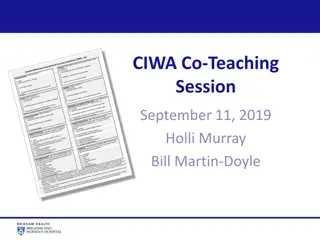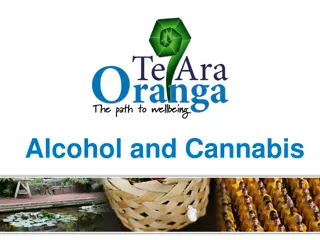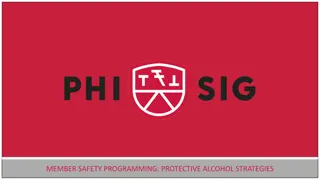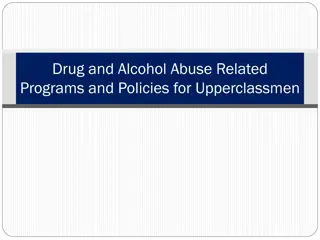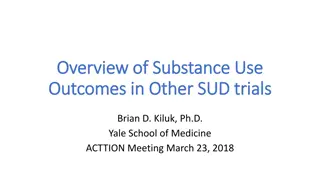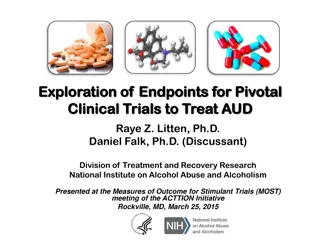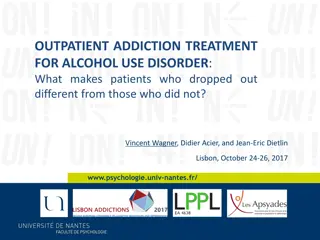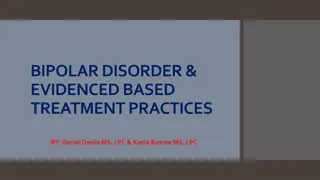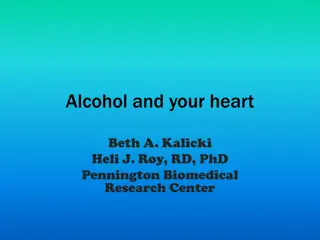Guidelines for Treatment of Alcohol Use Disorder
These guidelines aim to increase the number of clinicians offering evidence-based treatment for individuals with Alcohol Use Disorder (AUD), engage more New York State residents in treatment, reduce alcohol-related deaths, and promote a harm reduction approach. They address the prevalence of binge and heavy drinking, provide recommendations on treatment options including pharmacologic and behavioral therapies, and outline goals of treatment such as reducing alcohol use, improving mental health, and enhancing quality of life.
Download Presentation

Please find below an Image/Link to download the presentation.
The content on the website is provided AS IS for your information and personal use only. It may not be sold, licensed, or shared on other websites without obtaining consent from the author. Download presentation by click this link. If you encounter any issues during the download, it is possible that the publisher has removed the file from their server.
E N D
Presentation Transcript
Treatment of Alcohol Use Disorder www.hivguidelines.org JULY 2020 NYSDOH AIDS Institute Clinical Guidelines Program
Purpose of This Guideline Purpose of This Guideline Increase the number of clinicians in outpatient settings offering evidence-based treatment to individuals with AUD. Increase the number of New York State residents with AUD who are engaged in treatment. Reduce the number of alcohol-related deaths in New York State. Promote a harm reduction approach to treatment of AUD, which involves practical strategies and ideas aimed at reducing the negative consequences associated with alcohol use. See the NYSDOH AI guideline Substance Use Harm Reduction in Medical Care. JULY 2020 NYSDOH AIDS Institute Clinical Guidelines Program www.hivguidelines.org
Prevalence Prevalence 67.1 million individuals engaged in binge drinking on at least 1 day within the past 30 days, defined as 5 or more drinks at 1 occasion for men and 4 or more for women. 16.6 million individuals aged 12 or older engaged in heavy drinking within the past 30 days, defined as binge drinking on 5 or more days. JULY 2020 NYSDOH AIDS Institute Clinical Guidelines Program www.hivguidelines.org
Recommendations: Recommendations: Treatment Options Treatment Options Clinicians should inform patients with AUD about all available pharmacologic and behavioral treatment options and all available treatment settings, including outpatient primary care and addiction specialty treatment (intensive outpatient, inpatient, and residential treatments). (A3) Clinicians should recommend pharmacologic treatment for individuals with moderate-to-severe AUD. (A1) Clinicians should recommend oral acamprosate or oral or injectable extended-release (XR) naltrexone as the preferred medications for treating AUD. (A1) Clinicians and patients should choose a pharmacologic agent based on: (A3) Evidence-based recommendations. Ease of administration. Available formulations. Adverse effects. Presence of medical conditions (e.g., hepatic or renal disease, conditions that require treatment with opioids). Comorbid psychiatric conditions (e.g., depression, anxiety) and/or substance use disorders (e.g., opioid use disorder, tobacco use disorder). Presence of specific features of AUD (e.g., craving). Patient preference. Clinicians should recommend behavioral treatment for individuals with AUD. (A1) JULY 2020 NYSDOH AIDS Institute Clinical Guidelines Program www.hivguidelines.org
Goals of Treatment Goals of Treatment Staying engaged in care, which can also facilitate prevention, diagnosis, and treatment of other conditions. Reducing alcohol use. Reducing high-risk behaviors (e.g., driving while intoxicated, alcohol- related unprotected sex). Improving quality of life and other social indicators, such as employment, stable housing, and risk of incarceration. Improving mental health. JULY 2020 NYSDOH AIDS Institute Clinical Guidelines Program www.hivguidelines.org
DSM DSM- -IV and DSM IV and DSM- -5 Diagnoses 5 Diagnoses In most published studies of pharmacologic treatment for alcohol use, participants had a DSM-IV diagnosis of alcohol dependence, which approximately corresponds to moderate-to-severe AUD in the DSM- 5. Thus, recommendations for pharmacologic treatment in this guideline are made for patients who meet DSM-5 criteria for moderate-to-severe AUD. In most published studies of psychosocial treatment for alcohol use, participants had a DSM-IV diagnosis of alcohol abuse or alcohol dependence. Alcohol abuse approximately corresponds to mild AUD in the DSM-5. Thus, recommendations for psychosocial treatment in this guideline are made for patients who meet the current DSM-5 criteria for mild, moderate, or severe AUD. JULY 2020 NYSDOH AIDS Institute Clinical Guidelines Program www.hivguidelines.org
Recommendation: Recommendation: Managing Withdrawal Syndrome Managing Withdrawal Syndrome Before treating patients with AUD, clinicians should assess the need for withdrawal management and (A3): Manage mild to moderate withdrawal syndrome in an outpatient setting. Refer patients with severe withdrawal syndrome or other complicating conditions for inpatient management. JULY 2020 NYSDOH AIDS Institute Clinical Guidelines Program www.hivguidelines.org
Recommendations: Recommendations: Initiating Pharmacologic Treatment Initiating Pharmacologic Treatment PREFERRED: Acamprosate: For use if patients have the treatment goal of either reduction of or abstinence from alcohol use. Clinicians should perform serum CrCl testing before initiating treatment with acamprosate (A3); if CrCl is between 30 and 50 mL/min or eGFR is between 30 and 59 mL/min/1.73 m2, clinicians should adjust the dose according to prescribing information or choose another medication. (A2) Contraindication: Clinicians should not prescribe acamprosate for patients with a CrCl <30 mL/min or eGFR <30 mL/min/1.73 m2. (A2) For the best treatment response, clinicians should initiate treatment with acamprosate as soon as a patient has abstained from alcohol use and within 7 days. (A3) JULY 2020 NYSDOH AIDS Institute Clinical Guidelines Program www.hivguidelines.org
Recommendations: Recommendations: Initiating Pharmacologic Treatment Initiating Pharmacologic Treatment, continued PREFERRED: Oral or injectable Long-Acting Extended-Release (XR) Naltrexone: For use if patients have the treatment goal of either reduction of or abstinence from alcohol use. For patients with AUD who also use opioids, clinicians should administer a naloxone challenge and confirm that the patient has no reaction to ensure that opioids have been cleared from the system (see the NYSDOH AI guideline Treatment of Opioid Use Disorder > Implementing Opioid Use Disorder Treatment). (A2) Before initiating treatment with injectable XR naltrexone, clinicians should prescribe an oral trial of naltrexone (50 mg once daily for at least 3 days) to assure that the patient tolerates the medication. (A3) Clinicians should recommend XR naltrexone if adherence to an oral regimen is a concern. (B3) Because active alcohol use is not a contraindication to naltrexone, clinicians should initiate naltrexone even if patients continue to use alcohol. (A1) Contraindications: Clinicians should not prescribe naltrexone for individuals with acute hepatitis or liver failure; individuals taking opioid analgesics; individuals currently physically dependent on opioids, including those currently maintained on opioid agonists (e.g., methadone) or partial agonists (e.g., buprenorphine); or individuals in acute opioid withdrawal. (A2) JULY 2020 NYSDOH AIDS Institute Clinical Guidelines Program www.hivguidelines.org
Recommendations: Recommendations: Initiating Pharmacologic Treatment Initiating Pharmacologic Treatment, continued ALTERNATIVE: Disulfiram: For use if patients have the treatment goal of abstinence from alcohol use. Clinicians should consider disulfiram for individuals with AUD who have not responded to or are intolerant of naltrexone or acamprosate, or who may prefer disulfiram. (A3) Clinicians should advise patients that they should not take disulfiram until they have been abstinent from alcohol for 12 hours or longer. (A3) Clinicians should emphasize the importance of avoiding alcohol consumption in all forms to patients taking disulfiram. (A3) Clinicians should perform baseline liver function testing, including aspartate aminotransferase (AST)/alanine aminotransferase (ALT) levels, before initiating disulfiram treatment. (A3) In patients with AST/ALT levels >3 to 5 times the upper limit of normal, clinicians should avoid treatment with disulfiram. (A3) Clinicians should repeat liver function testing at least monthly during the first 3 months of treatment and every 3 months thereafter while the patient is taking disulfiram. (A3) Clinicians should discontinue disulfiram treatment in any individual with signs or symptoms of acute hepatitis or acute liver failure. (A3) Contraindications: Clinicians should not prescribe disulfiram for patients who have recent or concomitant use of metronidazole, paraldehyde, alcohol, or alcohol-containing preparations (e.g., cough syrups, tonics); coronary artery disease; recent myocardial infarction; psychoses; or signs or symptoms of acute hepatitis or acute liver failure. (A2) JULY 2020 NYSDOH AIDS Institute Clinical Guidelines Program www.hivguidelines.org
Good Practices: Good Practices: Disulfiram Disulfiram Emphasize that consumption of ANY alcohol during treatment with disulfiram can result in flushing, throbbing in head and neck, respiratory difficulty, nausea, copious vomiting, sweating, thirst, chest pain, palpitations, dyspnea, hyperventilation, tachycardia, hypotension, syncope, marked uneasiness, weakness, vertigo, blurred vision, and confusion. Inform patients that adverse reactions to alcohol ingestion may occur for up to 14 days after stopping disulfiram treatment. Advise patients to carry a wallet card or wear a medication bracelet that states they are taking disulfiram so this information will be available to emergency personnel in case of a severe adverse reaction. Educate patients taking disulfiram that alcohol may be found in cough and cold medicines, mouthwashes, tonics, sauces, vinegars, and other food or skin products. JULY 2020 NYSDOH AIDS Institute Clinical Guidelines Program www.hivguidelines.org
Recommendations: Recommendations: Initiating Pharmacologic Treatment Initiating Pharmacologic Treatment, continued ALTERNATIVES: Gabapentin or Topiramate: For use if patients have the treatment goal of reducing or abstaining from alcohol use. Clinicians should consider gabapentin or topiramate for individuals with AUD who have not responded to or are intolerant of naltrexone or acamprosate, or who may prefer gabapentin or topiramate. (A3) JULY 2020 NYSDOH AIDS Institute Clinical Guidelines Program www.hivguidelines.org
Key Points: Key Points: Gabapentin Gabapentin Because gabapentin can induce a sense of euphoria when taken in combination with other substances, especially opioids, benzodiazepines, or alcohol, there is the potential for misuse. Individuals may take gabapentin for recreational purposes, to control mood or anxiety, to intensify the effects of substance use disorder medication, or for intentional self-harm. If there is a strong concern about gabapentin misuse or diversion, clinicians may want to schedule monthly or more frequent follow-up visits and medication counts. JULY 2020 NYSDOH AIDS Institute Clinical Guidelines Program www.hivguidelines.org
Pharmacologic Treatment of Alcohol Use Pharmacologic Treatment of Alcohol Use Disorder in Nonpregnant Adults Disorder in Nonpregnant Adults Medication Dosage Considerations for Use Preferred Medications Contraindication: Patients with CrCl 30 mL/min or eGFR 30 mL/min/1.73 m2. See package insert for dose adjustments based on CrCl. Contraindications: Acute hepatitis or liver failure, concomitant use of opioid analgesics or opioid agonists (e.g., methadone or buprenorphine), acute opioid withdrawal. Abstinence from alcohol is not required for treatment. Abstinence from opioids is required for treatment. If possible, perform liver function testing (including AST/ALT testing) at baseline and within 12 weeks of initiating treatment. Discontinue naltrexone in the event of symptoms or signs of impaired liver function. Recommend the injectable formulation for patients who have problems with adherence to the oral regimen. Acamprosate oral (Campral) Initial and maintenance: 666 mg 3 times per day Naltrexone oral (Revia) Initial and maintenance: 50 mg once daily If adverse events occur, clinicians can consider a reduced dose of 25 mg once daily XR Naltrexone, long-acting injectable (Vivitrol) Initial: 50 mg oral naltrexone once daily for at least 3 days Maintenance: 380 mg intragluteal injection every 28 days JULY 2020 NYSDOH AIDS Institute Clinical Guidelines Program www.hivguidelines.org
Pharmacologic Treatment of Alcohol Use Pharmacologic Treatment of Alcohol Use Disorder in Nonpregnant Adults Disorder in Nonpregnant Adults, continued Medication Dosage Considerations for Use Alternative Medications Contraindications: Recent or concomitant use of metronidazole, paraldehyde, alcohol, or alcohol-containing preparations (e.g., cough syrups, tonics); coronary artery disease; recent myocardial infarction; psychoses; or signs or symptoms of acute hepatitis or acute liver failure. For all contraindications, see package insert. Use only in patients who want to completely abstain from alcohol. Inform patients of the disulfiram-alcohol reaction; reinforce complete abstinence from any form of alcohol. Advise patients to initiate disulfiram only after 12 hours of abstinence. Perform baseline liver testing before initiating disulfiram treatment. In patients with AST/ALT levels >3 to 5 times the upper limit of normal, avoid treatment with disulfiram. Repeat liver function testing at least monthly during the first 3 months of treatment and every 3 months thereafter while patient is taking disulfiram. Disulfiram oral (Antabuse) Initial and maintenance: 500 mg once daily for 1 to 2 weeks. Reduce to 250 mg once daily. Note: Concomitant use of disulfiram and alcohol, even small amounts, can result in the following adverse effects: flushing, throbbing in head and neck, respiratory difficulty, nausea, copious vomiting, sweating, thirst, chest pain, palpitations, dyspnea, hyperventilation, tachycardia, hypotension, syncope, marked uneasiness, weakness, vertigo, blurred vision, and confusion. Severe reactions may result in respiratory depression, cardiovascular collapse, arrhythmias, myocardial infarction, acute congestive heart failure, unconsciousness, convulsions, and death. JULY 2020 NYSDOH AIDS Institute Clinical Guidelines Program www.hivguidelines.org
Pharmacologic Treatment of Alcohol Use Pharmacologic Treatment of Alcohol Use Disorder in Nonpregnant Adults Disorder in Nonpregnant Adults, continued Medication Dosage Considerations for Use Alternative Medications Gabapentin oral (multiple brands) Initial: 300 mg once daily Titrate: Increase in increments of 300 mg Maintenance: Up to 3,600 mg daily, divided in 3 doses; dose is based on response and tolerance Caution: Gabapentin can be used alone for psychoactive effect or in combination with other substances, including opioids, benzodiazepines, and alcohol, to intensify the effects. Topiramate oral (multiple brands) Initial: 25 mg once daily Titrate: Increase dose by 50 mg increments each week to a maximum of 400 mg daily administered in 2 divided doses Maintenance: 200 to 400 mg daily divided into 2 doses A dose reduction by half is recommended for adult patients with CrCl 70 mL/min or eGFR 70 mL/min/1.73 m2. See package insert for full prescribing information. JULY 2020 NYSDOH AIDS Institute Clinical Guidelines Program www.hivguidelines.org
Need Help? Need Help? NYSDOH AIDS Institute Clinical Guidelines Program www.hivguidelines.org
Access the Guideline Access the Guideline www.hivguidelines.org > Treatment of Alcohol Use Disorder Also available: Printable pocket guide and PDF NYSDOH AIDS Institute Clinical Guidelines Program www.hivguidelines.org
